Bubble Top Cars





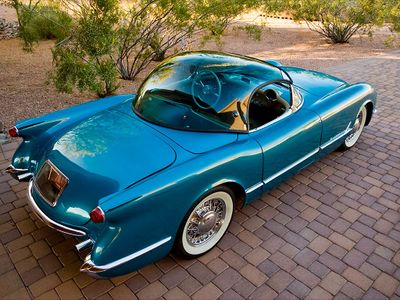

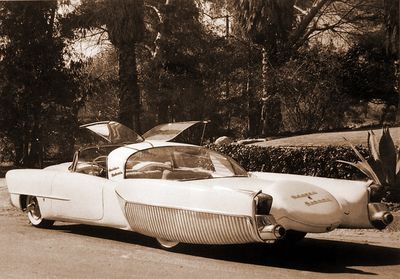








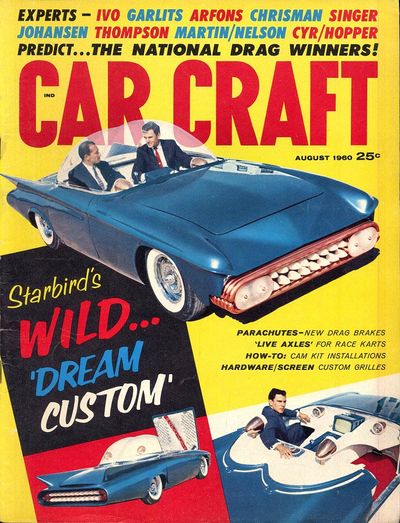

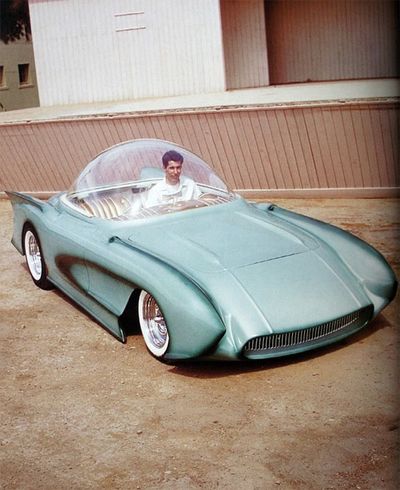
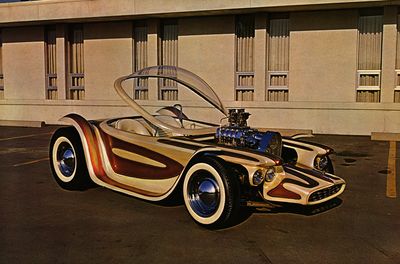
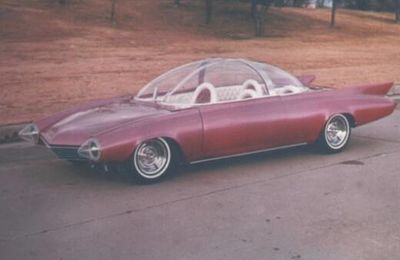








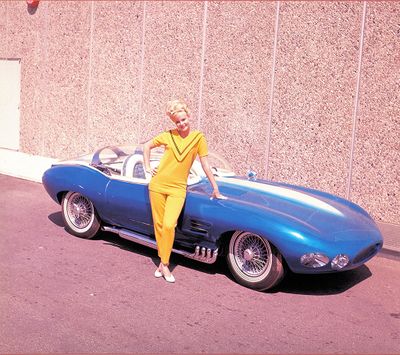







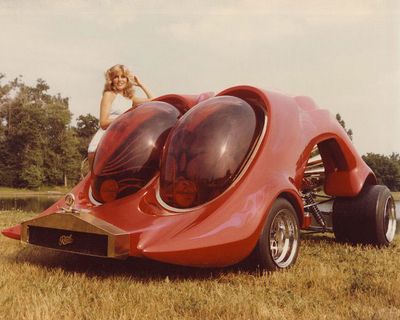

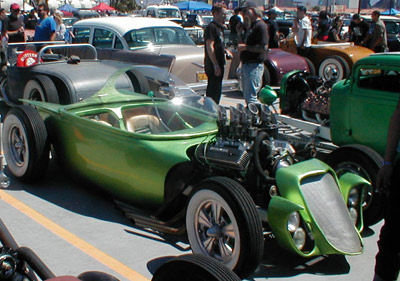

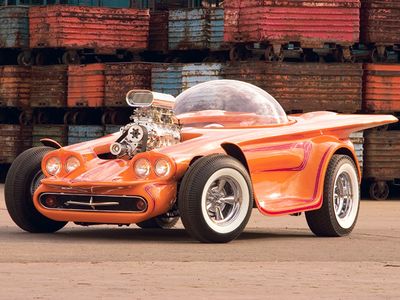
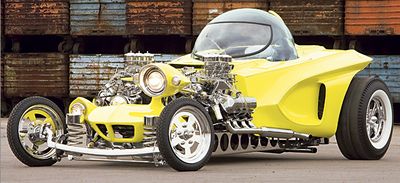

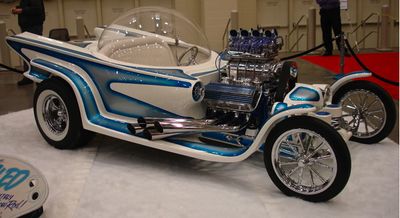

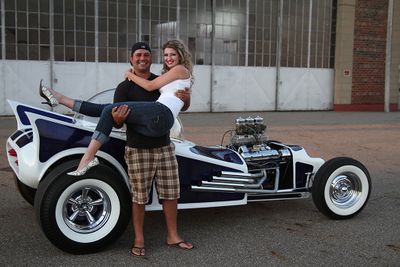






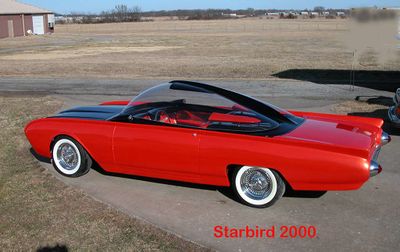


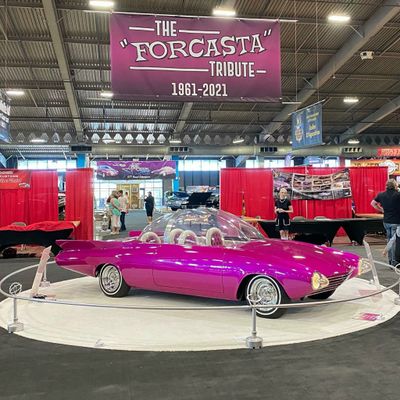




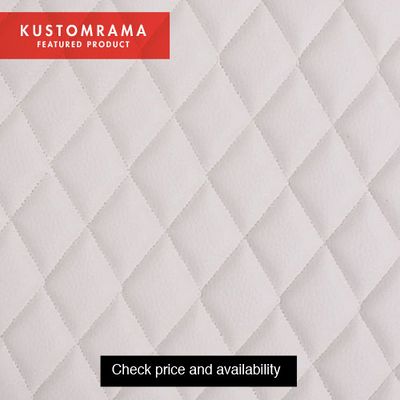
Since the introduction of plastic, creative minds have been dreaming about bubble-topped automobiles. In the 1950s futuristic dream cars swept the nation, and cars with Plexiglas domes in different shapes and variations were all the rage in the design studios of Detroit. In 1960 the trend reached the custom car scene, and every known and unknown customizer started building his or her own version of these futuristic rides. If you built one, they would come, and you were almost guaranteed at least one magazine cover shot and plenty of promotion for your shop.
Contents
- 1 Ralph Lysell's Rally
- 2 Detroit and Barris
- 3 The X-PAK 400
- 4 Darryl Starbird's Predicta
- 5 Built by Aliens
- 6 15 states in 17 weeks
- 7 I suffer from severe nightmares
- 8 Ron Aguirre's X-Sonic
- 9 Ed Roth's Beatnik Bandit
- 10 Starbird Resturns with the Forcasta
- 11 Ed Roth Takes Off
- 12 Bill Cushenbery's Silhouette
- 13 Holden and Korky
- 14 Dean Jeffries' Mantaray
- 15 The Bubble Bursts
- 16 The Second Wave
- 17 Bubble Topped Cars
- 18 References
Ralph Lysell's Rally
One of the first attempts of actually producing a bubble-topped car can be traced back to Oslo, Norway where Ralph Lysell in the early 1950s was busy building his Rally sports car. Lysell was an eccentric industrial designer born in Stockholm, Sweden. He had studied design and engineering at Columbia University in New York, and in 1949 he decided to move to Oslo. In his luggage, he had some sketches of a futuristic bubble-topped automobile named Rally. Lysell’s vision was to build what was meant to be the first Norwegian produced sports car of the 1950s. Unfortunately, only one prototype was built before the project was abandoned in 1951. So far, only production photos of the Rally-prototype without the bubble has surfaced, and nobody knows if Ralph made the bubble top for the car, or how long he came in the process of actually constructing a bubble.[2]
Detroit and Barris
Across the pond, Ford Motor Company did also have radical visions for the future, and in 1953 they debuted their Lincoln XL-500 concept car. The Lincoln XL-500 was presented to the public as a look into the near future, and one of the most striking features of the car was a tinted glass, glare-proof and heat-resistant, that topped the entire passenger compartment. In reality, it was a Plexiglas bubble canopy roof. The press loved it, and they predicted that all cars soon would have transparent Plexiglas bubble roof for all-around driver visibility. Around the same time, George Barris, always an innovator and a visionary custom car builder, was working on a futuristic 1953 Lincoln for Jim Skonzkes of Dayton, Ohio. Named the Golden Sahara, the first incarnation of Jim’s Lincoln featured a lift-off transparent roof with hinged panels above each door. A tinted T-bar kept it from becoming a full bubble top, and from the side, the design of the roof reminded about the roof on the XL-500. The Golden Sahara made its debut at the 1954 Petersen Motorama in Los Angeles, and it appeared on the cover of the May 1955 issue of Motor Trend as “The $25,000 car.” A year later Skonzakes had Indiana customizer Bob Metz and Ohio’s Delphos Machine and Tool modify the Golden Sahara further, turning it into the Golden Sahara II. This incarnation featured a custom half-bubble top.[2]
The same year as Barris Kustoms debuted the Golden Sahara, GM unveiled their first bubble top concept car; a sporty two-seater named the Pontiac Bonneville Special. The Bonneville Special featured a Plexiglass canopy with gull-wing doors. Ford Motor Company was on a roll, and they returned with the bubble-topped Ford FX-Atmos in 1954. Several Detroit-built bubble-topped dream cars followed in the coming years, such as the 1955 Lincoln Futura, that Barris turned into the Batmobile in 1966.[2]
The X-PAK 400
Enter the Space Age! In 1957 the Soviet Union launched Sputnik 1, the world’s first artificial satellite. In 1958 President Dwight Eisenhower signed a public order creating NASA, and in 1959 George Barris announced that space styled customs was the latest rage; “From the drawing board to the torch, customizers build for the future. Incorporating the most recent concepts of special automotive styling and techniques, these radical custom cars are the epitome of the country’s top coach work.” The top customizers in the country where now ready to take over where Detroit left off, with George Barris leading the race. The same year Barris Kustoms debuted the futuristic XPAK 400. Supposedly translated from Martian, the name meant air car, and that’s what it was. It had no wheels, transmission or rear end, but it moved on a five-inch cushion of air, and it was driveable on both land and water. In addition to huge fins and a groundbreaking sparkling Metalflake paint job, the XPAK 400 did also feature a plastic bubble top that had been vacuum formed over a male mold. A soft introduction, and a hint about what the future held. Motor Trend magazine lauded the XPAK 400 as “The most valuable contribution to the automotive industry of the year.”[2]
Darryl Starbird's Predicta
In February of 1960 Wichita, Kansas customizer Darryl Starbird introduced the bubble top to the custom car world for real, as he debuted his Predicta at the prestigious National Roadster Show in Oakland, California. Starbird was only 26 years old at the time, and he had just won the Sweepstakes and the Top Custom Shop Achievement Awards at the NHRA National Championship Custom Car Show in Detroit with Bob Turgeon’s 1957 Ford Thunderbird. Starbird was a rising star on the scene, and the Predicta was his first full-blown show car. Built in 11 weeks, it looked like nothing else at the show, with its custom-built body, a clear lucite plastic dome top, stick steering, and a cockpit-designed interior. The car arrived in Oakland without the top. The top was fabricated by a company called Lustre Craft. Lustre Craft and Starbird had a hard time getting the bubble to blow into the right dimensions for the car. Before they could take on the project, Lustre Craft had to fabricate an oven big enough to hold the 6x8-foot sheet of Lucite plastic to heat it, and after numerous attempts, and a great deal of experimenting, it was finally achieved, but not in time for Darryl to put it on the car before it left for Oakland. Once completed, the top was shipped directly to the show, where it was displayed beside the car.
Built by Aliens
Lenny Macchiarella attended the show with his brother Phil. Phil had his 1950 Plymouth on display three rows over, and in 2020 Lenny told Kustomrama that they thought the Predicta was built by Aliens![3] It won “The Car of the Future Award” at the Oakland show, and Motor Life magazine picked it as their Top Custom of the year in 1960. After the show, Darryl took the car directly to Peterson Publishing, where it was photographed for a featured story in the August 1960 issue of Car Craft. If you look closely at the cover photo you can see that the bubble is held in place by Darryl and Dick Day. Dick Day, the Editor of Car Craft, described the build as a “Dream Custom.”[4]
15 states in 17 weeks
After its debut in Oakland, the Predicta was sent on a 17 weeks tour in 15 states. It won major prizes everywhere it was exhibited, establishing Starbird as a respected custom and show car builder. Starbird and his companion Jerry Titus, toured caravan style with Ed Roth and the Outlaw that year. Starbird and Titus were pulling the Predicta with Starbird’s 1959 Buick, while Ed was pulling the Outlaw with a 1959 Cadillac Coupe DeVille. Ed was only getting $250 a show for featuring the Outlaw, while Starbird received $500. In his book, ”Darryl Starbird - The Bubble Top King,” Starbird explains how he thought he was king of the hill until he realized that Ed was selling 12-dozen, hand-painted t-shirts at each show for $5 each; “He was sending home nearly a $1,000 a week, where I was sending only $250. My bubble was soon busted; Ed was a real merchandiser and a seasoned traveler. He survived in a trailer during this time, took few baths, and lived on beanie weenies out of a can he cooked over a Coleman stove in his trailer. He was fascinated with the Predicta’s bubble. We spent many hours talking about the mechanics of doing one and he went back and built the Beatnik Bandit after the tour.”[4]
I suffer from severe nightmares
In the early 1960s, Popular Customs magazine asked Darryl where he got the ideas for his wild creations. “I suffer from severe nightmares,” he told jokingly before he continued; “Actually, though, my ideas don’t come in one fell swoop. When we’re working on one car, we continually think of ways to do the same job a little differently. I do some sketching at home, gathering ideas from here and there, magazines, and the futuristic ideas of other designers, including those who work entirely outside the automotive field. And we experiment-when we have the time-using 1/2 -inch conduit tubing we lay out full-size shapes of styling ideas.” In the same interview, Darryl was asked if he foresees the day when anyone with a convertible could buy an accessory bubble top and clip it right to his car. He did not; “A true bubble top requires the windshield be entirely removed. The present manufacture of bubbles demands the lower edge be on a plane; that is, we can’t blow up a bubble with one open end to match precisely the outline of a windshield frame. Bubbles are free blown, which means a piece of heated plastic is clamped on a jig and air pressure is admitted which swells the center portion of the bubble upward. Size is determined by the amount of pressure admitted to the jig and the shape is dictated by the outline of the jig. If restrictions were used, as would be the case were the bubble blown up into a female die, its optics would be ruined. Too, the bubble itself has to be reinforced around its lower edge, as does the body of the car where it attaches. So their installation on a car will always require extensive customizing. Another problem to be solved before the bubble becomes universally acceptable; the car gets unbearably hot when driven in the sun, Air conditioning helps solve this, of course. But I have heard Detroit is experimenting with minute flakes of aluminum mixed with the plastic before the sheets are rolled. The supposedlysupposdely reflect the heat away and do not interfere visibility. Until something like this is perfected, though, the only practical thing is a color-tinted bubble.”
Ron Aguirre's X-Sonic
Another well-known custom present at the 1960 National Roadster Show was Ron Aguirre’s X-Sonic Corvette. After the show, Ron and his good friend Ed Roth decided that they wanted to build “Feature” cars and get paid to show them, not just win trophies. Ron had already installed hydraulic lifts on the Corvette, and now he wanted to go futuristic, replacing the stock top with a plastic bubble. He tried using airplane canopies from aircraft surplus yards first, but they were cracked and split and foggy, and they weren't the right shape. Ron had previously made a set of red bubble taillight lenses for the X-Sonic by clamping heated plastic between two pieces of plywood. The top one had been cut out to the perimeter shape, and by blowing air through a hole in the lower piece the taillights had taken the right shape. These had been done at House of Plastics in San Bernardino, but as the House of Plastics didn't have a big enough oven for the top, he found a place in El Monte that had a big enough oven. Ron and his dad made a big plywood platform. They then put a tube in the middle with an air chuck and a shut-off valve. Ron's father had made a metal ring to Ron's pattern for the top. Armed with 40 to 50 C-clamps, and seven or eight assistants the plastic was heated in the oven. It was put on the base before the ring was put over and the plastic clamped down. After clamping it down, Ron started to pump air into it, a little at a time until he got the height he wanted. He then shut the air valve to keep it there until it cooled. Thanks to good planning and preparation the top was done on the first try. After Ron had explained how he made his top, Ed had a bubble top installed on his Beatnik Bandit.[5]
Ed Roth's Beatnik Bandit
As a concept, the Beatnik Bandit was first revealed to the public in the June 1960 issue of Rod & Custom magazine. Sketched by Joe Henning, the first incarnation of the Beatnik Bandit featured a Model T top. Surprisingly enough, Ed claimed that the idea for the bubble top on his car came from the Clarkaiser built Bobby Darrin’s Dream Car. According to the book “Hot Rods by Ed “Big Daddy” Roth” by Ed Roth and Tony Hacker, Ed called Detroit to find out what a bubble top would cost; “they’d tell me thousands o’ bucks so that I got this idea from Louie Aguirre to put some regular plastic in a pizza oven and then blow it up like a balloon while it was still hot.”[5] After touring the country with Darryl Starbird and the Predicta, it sounds strange that it was the Bobby Darrin Dream Car that inspired Roth to put a bubble dome on the Beatnik Bandit. According to Ed Roth authority Dave Shuten, the thing about Ed is, “Every time he’d tell a story...it’d be completely different… he liked to keep people guessing.”[2]
In April of 1961 Yuri Gagarin became the first person to orbit Earth, a month later Roth photographed the first bubble-topped incarnation of the X-Sonic for Rod & Custom Magazine. It was painted by Larry Watson, and it featured his first fade paint job. The bubble-top was hinged in the rear, and entry from the outside, by raising and lowering the top, was operated through pushbuttons found under the gas filler flap. Inside, a console between the front seats contained remote control buttons that operated the electrical steering, the doors, the bubble top, ignition, lights, and front suspension clearance. The Beatnik Bandit was completed around the same time, and also Roth’s build received one of Larry Watson’s premier paint jobs. Ed didn't have the money required to paint the car, so he made a deal with Watson that he could take all the time he needed on the car and that he got paid in Rat Fink T-Shirts. The top on the Beatnik Bandit was hinged in front, and it was operated by a fender mounted antenna. After the Beatnik Bandit, Roth’s show commitments got bigger and bigger, and show promoters all over the US wanted to display his radical builds. The Beatnik Bandit became the first show car that he hauled on a trailer 100% of the time.[5]
Starbird Resturns with the Forcasta
After successfully touring the Predicta all over the continent, Starbird shut down Star Kustom Shop and built a 7,500 square foot shop north of Wichita called Starbird Custom Auto Creations. He wanted to show the world that the Predicta was no fluke, so he immediately set out to build another bubble top car. Called the Forcasta, Starbird’s second coming was built for Chuck Miller of Columbus, Ohio. Chuck’s car was built on a 1960 Chevrolet Corvair Monza chassis. Starbird wanted a car with a very low hood, and he was actually looking into using a rear-engined Wolksvagen before he landed on the Corvair. The Forcasta was a four-seater, so an enormous bubble was blown to cover all heads of the passengers. It was split at the door line, and the front half was raised hydraulically for entry and exit. In February 1962 John Glenn became the first American to orbit Earth. The same month the Forcasta made its debut at the 1962 Oakland Roadster Show, and it was introduced to readers all over the world through the cover of Car Craft and Kart Magazine March 1962. Always trying new things, Starbird had now built the first known four-seater bubble top custom.[4]
Ed Roth Takes Off
After the Beatnik Bandit, Ed Roth decided to challenge George Barris, building a bubble-topped air car on his own. While the Barris’ air car was well built, Roth’s Rotar was a little rougher. The XPAK 400 featured no frictional moving parts at all, and power came from two jet aircraft starter motors. Roths Air Car, on the other hand, was powered by two Triumph engines that he had turned on their sides and fitted with high-pressure propellers. Roth’s air car was completed in 1962, and in his book, Roth shares some memories about how he and George used to battle at the shows with their aircars; “The biggest battle of all at the car shows was with George Barris. It was too serious to be funny. I mean he was the head man. Numero Uno. The guy was out front. We had both built air cars & at first we’d just set ‘em in the shows & not demonstrate ‘em but the hear from the public put us both on the spot. Whenever I’d unload “Rotar” at the shows & the newspapers reporters were there I’d make a big point out of telling them that I’d demo Rotar & it would lift higher than the Barris air car. It got hot at times ‘ cause Barris I were miles apart in our thinkin’ in those years. It was a unfriendly feud that stopped when Rotar blew up & scattered parts into the crowd as Ron Aguirre was doing the demo at Cobo Hall in Detroit in ‘62. Barris won! My eternal apologies to those people, especially an unnamed lady who suffered for many years after.”[5]
Bill Cushenbery's Silhouette
A couple of years after the Predicta had taken the nation by storm, there was still just a handful of bubble-topped hot rods and customs around. But the foundation had been laid, and bubble top builds slowly started to pop up all over the US. By then, Darryl Starbird had become the most influential customizer in the midwest, and according to Car Craft magazine, he played a major role in setting the custom trends in the Midwest. In 1962 Car Craft magazine asked Starbird about his custom forecasts for 1962, and Starbird answered that 1962 would see a move toward the full radical custom; “Not customs as we have known them in the past few years, but customs as they were thirty years ago: hand built from the chassis up.” Gene Winfield forecasted the same; “An important item this year will be radical show cars - more radical than you have seen in the past. We used to have five or six kinds of customs - radical, semi-radical, medium, semi-medium, mild: now we will have two or three classes and the radical cars will be designed strictly for shows.” In Monterey, California Bill Cushenbery was busy building space-type rods, as he called them. “Wild, rocket-like rods designed for shows.” Cushenbery was rated by many as the best new customizer in America in 1962, and one of the cars he was working on at the time was a futuristic show car called the Silhouette. Cushenbery opened up his first body shop in Wichita, Kansas in 1952. After five years in business he found out that the custom car market in town was dominated by Starbird, so he decided to move his operations out West. The Silhouette was the first scratch built custom to roll out of Bill’s Monterey shop, and he won the first place in the “Tournament of Fame” contest with the car at the 1963 National Roadster Show, beating Darryl Starbird’s three-wheeled Futurista.[2]
Holden and Korky
The same year as Cushenbery took Oakland by storm, Detroit, Michigan customizer Tom Holden flabbergasted the visitors at the 1963 Detroit Autorama with a twin-bubble-topped 1959 Chevrolet El Camino called the Ultimus, and even farther East Dick “Korky” Korkes was busy building a bubble-topped 1962 Jaguar XK-E for Bobby Freedman. Built out of a fastback coupe, Bobby’s Jaguar featured a double bubble that was split by a center panel with chrome bands across the roof. When George Barris saw the car, he offered Korky a position as shop foreman at Barris Kustoms. Korky took the offer and solicited Freedman to pay his way out to California. Freedman agreed and Korky packed up, installed a tow hitch on the Parisian, rented an U-Haul, loaded on the Jaguar and headed out West. Never to look back again.[2]
Dean Jeffries' Mantaray
1963 was also the year Dean Jeffries set out to build a bubble top show car. Jeffries wanted to prove that he was capable of competing head to head with top customizers such as George Barris and Gene Winfield. The entire chassis on the Mantaray came from a pre-war Grand Prix Maserati. Incorporating asymmetrical design, the body was hand-formed in aluminum by Jeffries and helper Jim Burrell. The bubble top, lights, and engine on the car could be operated by a radio control system, and the Mantaray put Jeffries in the winner’s circle at the 1964 National Roadster Show in Oakland where he won the prestigious Tournament of Fame award.[2]
The Bubble Bursts
The bubble top craze was a shortlived fad. A bubble that would eventually burst in the mid 1960s. Ed Roth had a short and intense affair with bubble top cars, and from 1961 to 1964 he built five in total. Darryl Starbird never stopped, and he is still building them today. In 2018 Darryl told Sondre Kvipt of Kustomrama that out of the 200 or 300 cars he has built in his lifetime, 16 have had bubble tops. He has won “The Car of the Future Award” four times with four different bubble top builds, and he will always be remembered as “The Bubble Top King.”[2]
The Second Wave
There weren’t many bubble tops built after Apollo 11 landed on the moon’s surface in July of 1969. America had won the space race, and bubble top cars eventually became relics of our past, only to be seen in magazines, old books and in museums. Then, in the late 1990s, a show rod renaissance was underway. One of the pioneers leading the way was Shifters of So. Cal. car club member Anthony Castaneda. With roots going back to 1992, the Shifters of Southern California are known as the first nostalgia hot rod club for the younger guys being at the forefront of the revived traditional hot rod and custom car movement. Anthony’s contribution to the renaissance was a green Metalflaked homage to Ed Roth called the Brown Neck Bandito. Sporting a 1959 Chevrolet deck lid, a Plexiglas bubble top, and Radir wheels, the Brown Neck Bandito was shown partially completed at the 2nd annual Anti-Blessing in 2000. It caught everyone’s attention at the show, and it went on to ignite a spark amongst a new generation of bubble top fans and creators. Fans that just knew Ed Roth’s wild builds through magazines and old photos. Part of the same movement was also Mark Moriarity, who around the same time was working on a bubble top show rod called the Futurian in Minnesota. After restoring the Rotar and the Road Agent, Mark figured he would try his hand at an Ed Roth inspired show car of his own. The build was started in 1998 and completed in 2001. Fritz Schenck followed, and in 2005 he debuted a fiberglass bubble top show rod called the Roswell Rod at the Detroit Autorama. Just as the Futurian, the Roswell Rod was a tribute to Ed Roth, and it made its public debut next to a clone of the Mysterion that Dave Shuten just had completed. Two years later, Shuten returned with another build, this time a fiberglass self-penned bubble top creation named the Astrosled. A movement was on the rise, and in 2008, things really took off, when Aron Grote debuted the Atomic Punk. The Atomic Punk didn’t follow the old rulebook, and it looked more like a tribute to the Brown Neck Bandito than any of the Roth cars. Aaron started the build with a 1959 Plymouth that he cut up and narrowed down to form a body. Everything else was then built around the basic shape before Aaron topped it off with Candy Red paint and plenty of chrome. Timing is everything, and the car became an overnight success, inspiring backyard builders all over the world. Suddenly old quarter panels and headlight rings were welded together and turned into the most creative show rods.[2]
Bubble Topped Cars
1947 Delahaye 148L by Oblin
Irvin Kirschner's 1955 Chevrolet Convertible - The Pirate
Gary Fioto's 1955 Ford - The Beatnik
Ron Aguirre's 1956 Chevrolet Corvette - X-Sonic
J.P. Danos' 1958 Chevrolet Biscayne - Fantabula
Dick Scully's 1958 Ford Thunderbird - The Electra
Tom Holden's 1959 Chevrolet El Camino - Ultimus
Scott Wiley’s 1960 Ford Fairlane - The Spaceliner
Don Boeke's 1961 Chevrolet Corvette - Ramses II
Darryl Starbird's 1961 Ford Thundetbird - The Starbird 2000
Bobby Freedman's 1962 Jaguar XK-E
Jerry Greenwade's 1964 Chevrolet Corvette - The Cosma Ray
Marco Hämäläinen's 1975 Saab 96 - WaSaabi
Aaron Grote's Atomic Punk
Anthony Castaneda's Brown Neck Bandito
Bill Cushenbery's Silhouette
Bill Cushenbery's Silhouette II Space Coupe
Cody Burghdorf's Busch Light Bubble
Colin Hillier-Daines' Agent Thor
Darryl Starbird's Futurista
Darryl Starbird's Predicta
Dave Shuten's Astrosled
Dave Shuten's New Mysterion
Dean Jeffries' Mantaray
Ed Roth's Beatnik Bandit
Ed Roth's Beatnik Bandit II
Ed Roth's Road Agent
Ed Roth's Mysterion
Ed Roth's Orbitron
Ed Roth's Rotar
Everett Reynolds' Forcasta Tribute
Fritz Schecnk's Roswell Rod
Ian Roussel's Space Junkie 2.0
Luke Ennion's Little Menace
Mark Moriarity's Futurian
Paul Bacon's Cosmotron
Paul Wirt's Experimental Car
The Forcasta
The Stiletto
The Atomic Punk
The Astra-Gnome
Eric Goodrich's Iron Lung
XPAK 400
The Roach Coach
References
Did you enjoy this article?
Kustomrama is an encyclopedia dedicated to preserve, share and protect traditional hot rod and custom car history from all over the world.
- Help us keep history alive. For as little as 2.99 USD a month you can become a monthly supporter. Click here to learn more.
- Subscribe to our free newsletter and receive regular updates and stories from Kustomrama.
- Do you know someone who would enjoy this article? Click here to forward it.
Can you help us make this article better?
Please get in touch with us at mail@kustomrama.com if you have additional information or photos to share about Bubble Top Cars.
This article was made possible by:
SunTec Auto Glass - Auto Glass Services on Vintage and Classic Cars
Finding a replacement windshield, back or side glass can be a difficult task when restoring your vintage or custom classic car. It doesn't have to be though now with auto glass specialist companies like www.suntecautoglass.com. They can source OEM or OEM-equivalent glass for older makes/models; which will ensure a proper fit every time. Check them out for more details!
Do you want to see your company here? Click here for more info about how you can advertise your business on Kustomrama.






